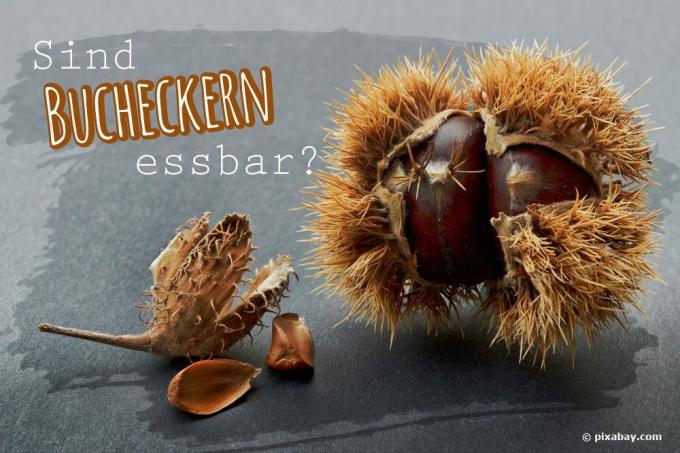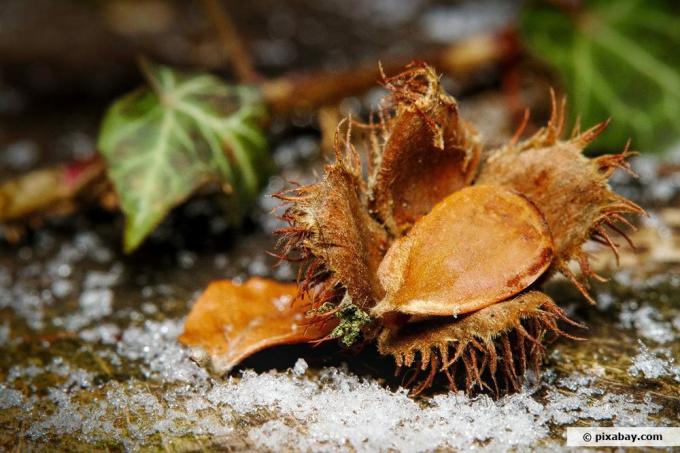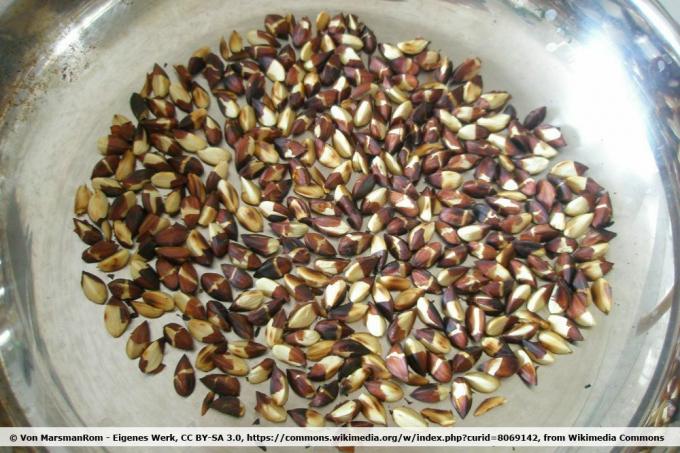
table of contents
- Fruits of the common beech
- Healthy but Toxic?
- Also poisonous for animals!
- Making beechnuts edible
- Peel the beechnuts
- Use in the kitchen
Beechnuts are considered a delicacy among birds and numerous rodents, but the nuts were once very popular in human nutrition. In times of need after the Second World War, oil was pressed from the nuts, which was used both in the kitchen and as lamp oil. Even today the nuts are a valuable ingredient in many recipes, although they are known to be poisonous. We explain why the fruits of the European beech can be eaten dangerously but without hesitation.
Fruits of the common beech
The beechnuts are the fruits of the red beech, which bears fruit for the first time from around 40 to 80 years of age. From then on, a crop of fruit can be expected about every five to eight years, with the first fruits usually ripe from September. The harvest is particularly productive after a dry, hot year. However, the harvest is alternating, so that a plentiful harvest is always followed by a smaller harvest. If the climatic conditions are good, the European beech produces numerous fruits with the following properties:
- sharp-triangular
- ovoid
- about 1.5 cm tall
- The nuts are surrounded by a brown shell
Healthy but Toxic?
The fruits of the common beech are an energy-rich food for humans and numerous animals. Because they are characterized by a fat content of around 40 percent and provide a number of minerals and trace elements such as zinc and iron. However, the nuts also contain poisonous substances such as the alkaloid fagin and oxalic acid. It should be noted, however, that raw nuts in particular have an increased content of these toxins. Excessive consumption of raw beechnuts can therefore lead to symptoms of intoxication with the following symptoms:
- stomach pain
- headache
- Shortness of breath
- Vomit
- Ringing in the ears
- Dizziness
Note: To date, there is no concrete information on how many raw beechnuts can be safely consumed. While healthy adults can eat a handful of the fruits raw, children and pregnant women should not eat raw nuts to be on the safe side.

Note: Please note that this article does not in any way replace a visit to the doctor. There is no guarantee that medical statements are correct.
You will find detailed information on first aid in the event of poisoning and important information on poison control centers here.
Also poisonous for animals!
While numerous birds and rodents prefer to eat the fruits of the European beech, they pose a threat to other animals. Because the nuts are poisonous and seriously dangerous for calves, horses and dogs, among other things. Because in larger quantities the nuts can not only cause symptoms of poisoning, but even lead to death from respiratory paralysis. The following symptoms may appear in animals after eating beechnuts:
- Dilation of the pupil
- Difficulty breathing
- Trembling and staggering
- Colic
- diarrhea
- cramps
- paralysis
Note: If poisoning is suspected, a veterinarian should be consulted immediately!
Making beechnuts edible
The fruits of the red beech contain, among other things, oxalic acid, which is also found in spinach and rhubarb. Oxalic acid can, however, be bound and thus made more tolerable for the body by simply combining it with dairy products. The toxin fagin contained in beechnuts, on the other hand, can be neutralized by heat, as it is not heat-resistant. There are two different methods of making the nuts edible:
- toast in a pan without adding any oil
- Advantage: better aroma
- Scald with hot water
- Advantage: the shell is easier to remove
Peel the beechnuts
However, before the nuts end up in the pan or pot, they must first be peeled. However, this process can be quite tedious with a large number of nuts, but there is also one or Another trick: not all pods are actually filled, so that excess work can be avoided in advance leaves. Whether there are valuable seeds in the pods can often be seen by the weight of the nuts when they are picked up. Particularly light specimens can therefore be sorted out beforehand. Proceed as follows with the leftover nuts:
- Peel nuts
- Cut the tip with your fingernails
- peel off one side of the triangular sleeve
- Put the seeds in a glass of water
- Seeds that sink to the bottom are "good yield"
Note: The nuts that linger on the surface of the water are usually only filled with a very small seed or not at all. However, these do not have to be disposed of, but can be fed to birds and squirrels in the garden.
Use in the kitchen
The fruits of the red beech impress with their nutty aroma and are therefore suitable for a wide variety of recipes. If you own an oil press, you can make a high-quality oil from the nuts. Because 100 grams of beechnut oil contains around 15 grams of saturated fatty acids, 50 grams of oleic acid and 35 grams of linoleic acid. Alternatively, the nuts can also be roasted or ground into flour and processed further:
- Ground into flour: bread and biscuits
- whole nuts: as an ornament on cakes or tarts
- freshly roasted: sprinkle over salads, ideal for autumn salads
- for nibbling: roast the nuts and then roll them in salt or spices
- process into coffee

Note: Healthy, adult people can safely eat a small amount of raw nuts.
